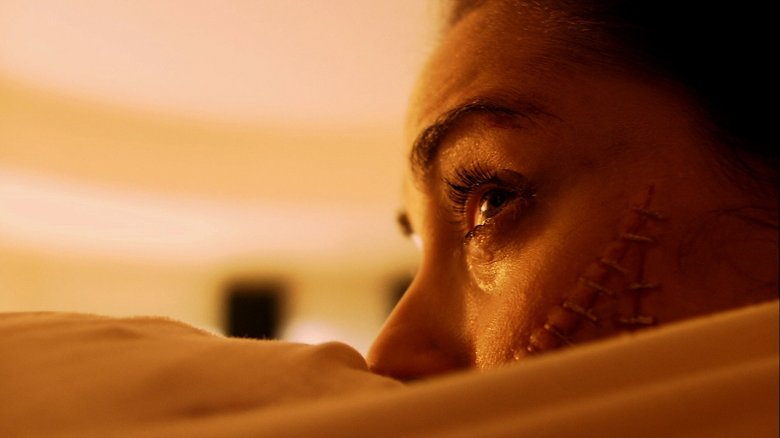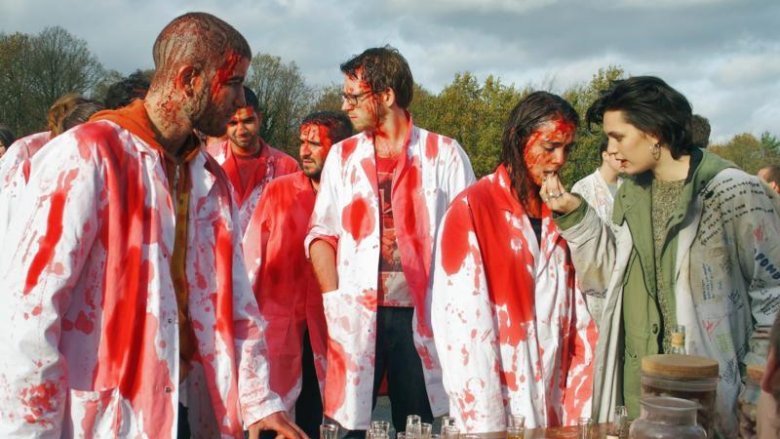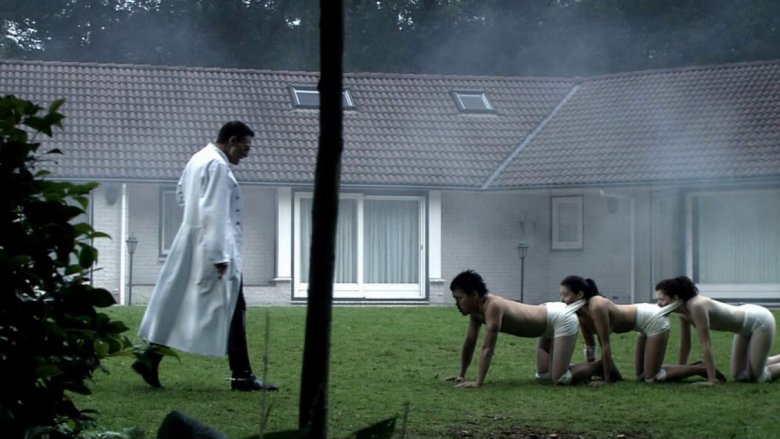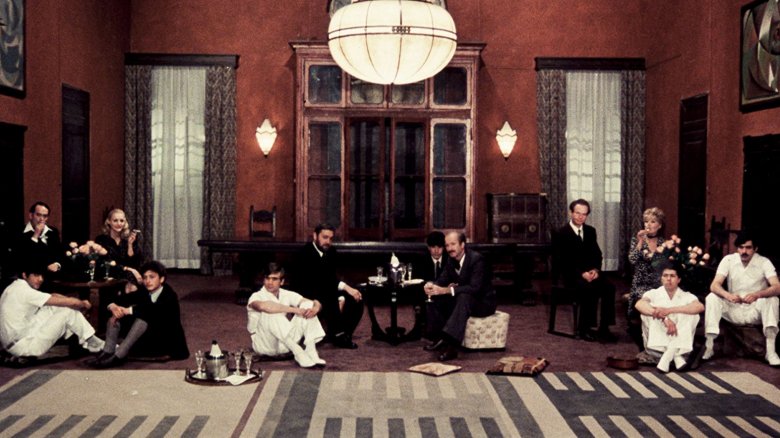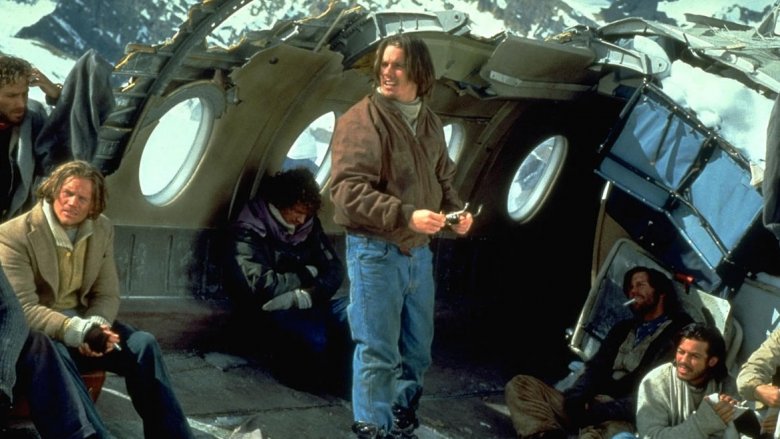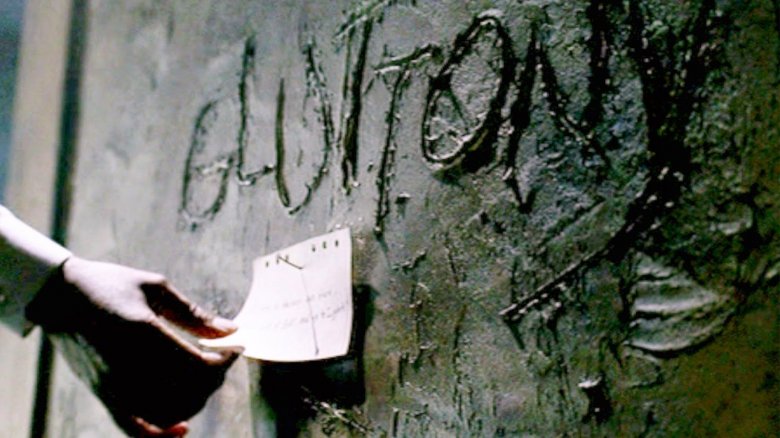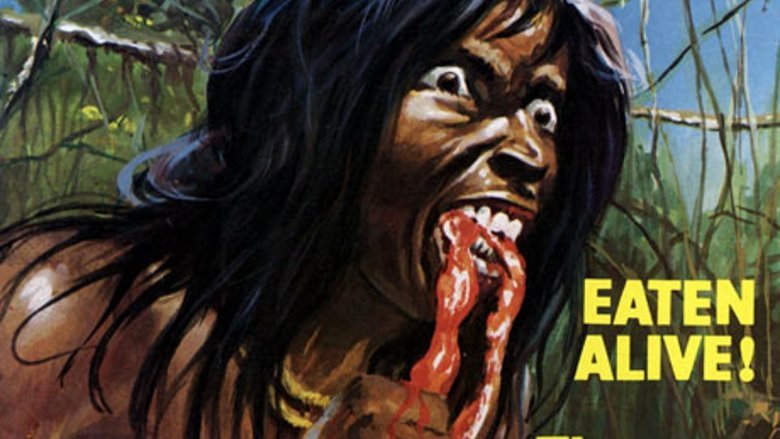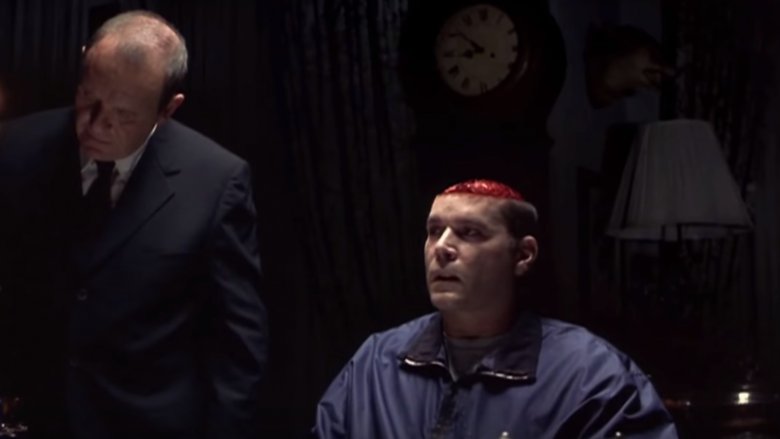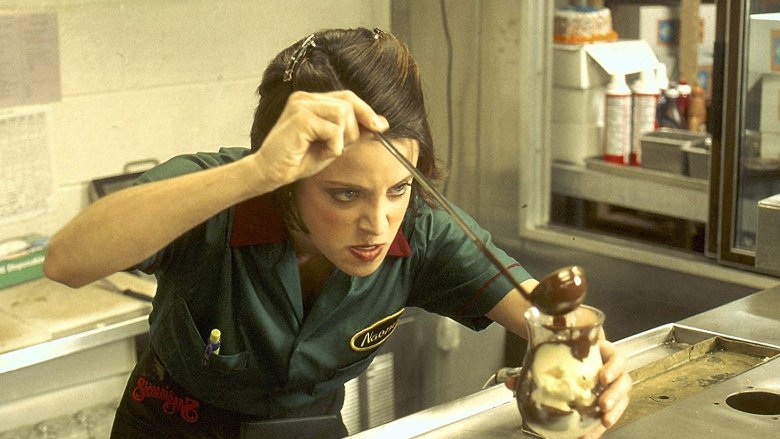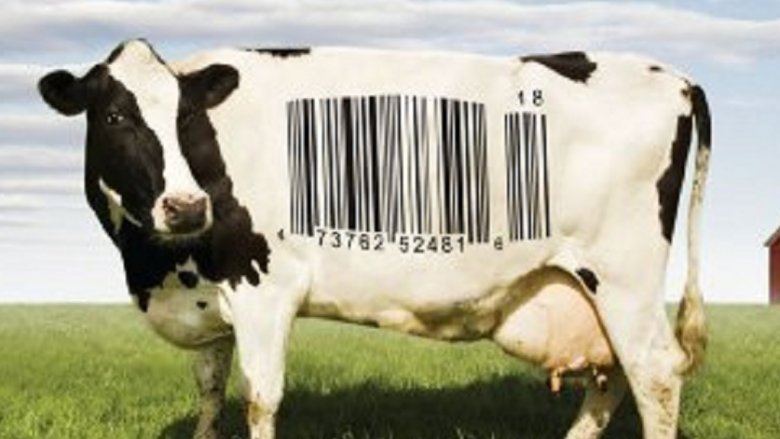Movies You Should Definitely Never Watch While Eating
Considering the fact that food and beverage sales keep many theaters financially afloat, nommage is definitely a major factor for most moviegoing experiences, but not every cinematic experience pairs well with a hearty appetite. In fact, there are a ton of movies that might actually deter an audience from eating any time soon — or perhaps even cost them their lunch.
When it comes to these films, there are plenty of food — er, some kind of eating — scenes, but they are so sickening that they could easily be substituted for even the most effective dieting technique because no one's going to be walking away hungry after seeing them. From moments of gross body horror to people putting things in their mouths that were never meant for human consumption to some downright savage glimpses at the food and beverage industries, here are a few films you should never watch while wielding a fork.
Raw
Julia Ducournau's feature-length debut got a lot of love from festival screeners in its 2016 bow, but chances are none of those rave reviewers went home and ordered a heaping meat dish after seeing the film. Raw tells the story of a young vegetarian woman named Justine (Garance Marillier) who attends the same veterinary school as her sister and is forced to eat raw rabbit meat as part of a hazing ritual. If that image isn't unappetizing enough, she soon discovers that she has a real taste for flesh — and not just that of animals.
Justine becomes obsessed with eating human body parts and goes to great lengths to sate her newfound desire, which results in increasingly repulsive scenes of cannibalism involving victims both dead and alive during her mealtimes. The movie was ultimately celebrated for its daring conceptual framework and sophisticated messaging about the coming of age experience, but the unsavory aftertaste of the film was still probably hard to forget.
The Human Centipede (First Sequence)
Dutch filmmaker Tom Six proved he has a pretty sick mind indeed when he unveiled the first of his Human Centipede trilogy films in 2010. The Human Centipede (First Sequence) may have been met with mixed reviews, but word still spread quickly of the unique horrors his film contained, making it a must-watch for enthusiasts of the macabre. The film follows a pair of stranded travelers who find themselves in the clutches of a crazed surgeon named Dr. Heiter (Dieter Laser) who spent his life separating Siamese twins and now wants to reverse engineer what he calls a "human centipede" by stitching mouths to bottoms to form one long digestive tract between his victims.
The procedure itself is reviling and shocking, as the two are attached to another of his kidnapping victims, but things get even more foul once the feces starts flowing. Six somehow managed to make the two sequels even more loathsome to behold, but there's no doubt the craven nastiness of the first warned everyone that none of his films would be suitable for suppertime.
Salò, or the 120 Days of Sodom
There are a lot of reasons why a screening of Salò, or 120 Days of Sodom will not pair well with dinner, as it contains some of the most notorious scenes of human depravity ever committed to celluloid. The 1975 Pier Paolo Pasolini film remains relevant for its scathing critique of Italy's history of fascist rule, but the sheer mercilessness of its violence and sadism make it a difficult watch for even those with the most composed constitutions.
The film centers on a group of four powerful men who join forces to torment a gaggle of young people with rape and murder and humiliation, and things get even more stomach-churning when they start force-feeding these kids everything from nails to excrement. There are few scenes in the movie that don't qualify as an absolute melee to all audience sensibilities, but the upchuck factor is only intensified with every bite these victims are made to take throughout the film.
Alive
The true story of how more than a dozen members of the Uruguayan rugby team managed to survive the crash of their flight into the freezing Andes mountains in 1972 is undeniably compelling. Based on Piers Paul Read's book of the same name, Alive unveils the harrowing journey they all went through as their ranks were slowly thinned thanks to the crash itself and their subsequent deadly battles with the elements, injuries, and diseases.
As hope of rescue and supplies alike began to dwindle for the athletes, they were forced to make the terrible decision to stave off starvation by sustaining themselves on the flesh of their fallen teammates, whose bodies were preserved by the relentless snow that trapped and threatened them all. The 1993 Frank Marshall film takes care not to exploit the situation, but that doesn't stop it from being disgusting when they're shown carving up and chowing down on their poor friends' lifeless bodies.
Se7en
When it comes to David Fincher's filmography, Se7en still stands out as a seminal piece of his work for the unflinching detail he paid to the pain and philosophical horrors wrought against the film's many victims. The movie centers on a pair of detectives tackling a murder mystery in which the killer has methodically culled his marks for being exemplary of one of the seven deadly sins (a lawyer for greed, a sex worker for lust, e.g.), and some of the shots of his "work" are unsparingly violent.
It's not just the bloodshed that ups the ick factor of this movie, though; the film's most gruesome moments feature mental torture, and a few of them are bound to have people reaching for barf bags after watching. In one scene, for example, our heroes discover what they think is a withered corpse left to rot in a rank apartment, but it's actually an extremely emaciated man whose mind and body have both begun to dessicate. At another crime scene, they discover a morbidly obese man who was forced to eat until he passes out, with his stomach bursting open somewhere along the way. The latter might scare people away from that plate of spaghetti, but most of the movie might be best served with a shot of anti-nausea meds.
Cannibal Holocaust
Movies about cannibal tribes aren't as rare as they once were, but Cannibal Holocaust remains one of the most disturbing installations of the sub genre. The 1980 Italian film follows a documentary crew on a rescue mission to the Amazon to find another crew who'd gone missing as they tried to gather tape of indigenous tribes and resorted to extreme measures and even sexual violence to get their shots. Between the contents of the unsettling found footage, a slew of (real) animal carcasses scattered about, corpse violation, and one particularly degenerate scene of impalement, the movie is not for the faint of heart and certainly won't inspire any sudden urge for lunch.
In fact, the movie is so graphic that its director Ruggero Deodato was actually arrested for obscenity and murder, as it was suspected of being a snuff film whose human victims were real. Eventually, he was cleared of the latter crime once the cast presented themselves to prove that they were not actually mangled and mutilated bodies left to rot with the tribes, but the film is still infamous for its searing brutality.
Ōdishon (Audition)
Takashi Miike's career behind the camera has consisted of quite a few noteworthy accomplishments, but none of his movies are quite as notorious as Ōdishon (the Japanese word for "audition"). The 1999 film centers on a widowed man who is talked into returning to the dating scene and has a filmmaker friend who helps him hold an audition for the role of being his new wife. The woman he ultimately chooses, however, is not the spritely catch he thinks she is.
He eventually discovers her trail of deception and hacked-off body parts and finds himself on her chopping block after she drugs his drink. What happens to him is unseemly enough — let's just say it gives all-new meaning to the phrase "eye-popping" — but what he witnesses happening to the woman's other victim is what will really test a person's digestive tolerance. The other sap she has kidnapped, tortured, and dismembered is so hungry that he voraciously supps on the vomit she serves him in a dog dish. Blech.
Hannibal
There are plenty of scenes in The Silence of the Lambs that might make a person squirmy, especially when Hannibal Lecter (Anthony Hopkins) discusses making a meal of a man's liver with fava beans and chianti with excruciating enthusiasm. However, its less-celebrated sequel, Ridley Scott's 2001 film Hannibal, offers quite a few even queasier moments.
In this segment of the bad doctor's story, he's now on the loose in Europe and enjoying the local cuisine for entirely different reasons than most. It's a game of cat and mouse between him and Special Agent Clarice Starling (played by Julianne Moore this time), as she's been hired to track him down by Hannibal's only surviving victim, who happens to be a powerful millionaire. Even though she finds him, he's much too slippery and manipulative to be taken down by traditional measures, so the crimes continue. The grossest highlights from his path of destruction include his victim being eaten alive by a group of hungry boars and a law enforcement official on the case sitting down for dinner with his own brain serving as the main course. Mastication never looked so nasty.
Waiting...
Chain restaurant frequenters might want to steer very clear of this 2005 comedy if they ever hope to enjoy such patronage again. Sure, Waiting... is brimming with then-up-and-coming funny people like Ryan Reynolds, Anna Faris, Justin Long, and Dane Cook, but what goes on in the kitchen does not stay in the kitchen in this raunchy film.
As its title indicates, the movie is all about a group of waiters who are completely jaded by the daily humdrum of the service industry, so to liven things up a bit, they sometimes punish their less pleasant customers by spiking their plates with extra ingredients that don't come from the pantry. It's bad enough to imagine why restaurant bathrooms need to remind their staffers to wash their hands after using them, but to see just how loose these characters are with basic sanitation is enough to make someone skip dining out altogether.
Food, Inc.
Robert Kenner's 2008 documentary about the farming and agricultural business in America is not for those with weak stomachs, but it's a necessary watch all the same. Food, Inc. chronicles the many concerning methods that are used to produce food for consumers, from the inhumane techniques used to raise and butcher animals to the environmentally unfriendly ways grains and vegetables are grown.
The former segment in particular is bound to be an effective nudge for those audience members who might be considering going vegan or at least splurging on the cage-free, free-range, and/or organic options at the supermarket. From showing livestock wading knee-deep in their own manure (and thus risking the spread of dangerous diseases like E. coli) to the revelation that certain animals are being genetically designed to enlarge their size to the fillers and additives that are put into meats, it's quite hard to get a hankering for a hamburger after witnessing what really goes into making the proverbial and literal sausage in this movie. As the film's logline promises, "you'll never look at dinner the same way again."
